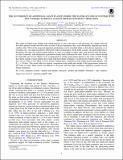| dc.contributor.author | Schlaufman, Kevin C | |
| dc.contributor.author | Winn, Joshua Nathan | |
| dc.date.accessioned | 2018-03-20T13:40:30Z | |
| dc.date.available | 2018-03-20T13:40:30Z | |
| dc.date.issued | 2016-06 | |
| dc.date.submitted | 2016-04 | |
| dc.identifier.issn | 1538-4357 | |
| dc.identifier.issn | 0004-637X | |
| dc.identifier.uri | http://hdl.handle.net/1721.1/114234 | |
| dc.description.abstract | The origin of Jupiter-mass planets with orbital periods of only a few days is still uncertain. It is widely believed that these planets formed near the water-ice line of the protoplanetary disk, and subsequently migrated into much smaller orbits. Most of the proposed migration mechanisms can be classified either as disk-driven migration, or as excitation of a very high eccentricity followed by tidal circularization. In the latter scenario, the giant planet that is destined to become a hot Jupiter spends billions of years on a highly eccentric orbit, with apastron near the water-ice line. Eventually, tidal dissipation at periastron shrinks and circularizes the orbit. If this is correct, then it should be especially rare for hot Jupiters to be accompanied by another giant planet interior to the water-ice line. Using the current sample of giant planets discovered with the Doppler technique, we find that hot Jupiters with P[subscript orb] < 10 days are no more or less likely to have exterior Jupiter-mass companions than longer-period giant planets with P[subscript orb] ≥ 10 days. This result holds for exterior companions both inside and outside of the approximate location of the water-ice line. These results are difficult to reconcile with the high-eccentricity migration scenario for hot Jupiter formation. | en_US |
| dc.publisher | American Astronomical Society/IOP Publishing | en_US |
| dc.relation.isversionof | http://dx.doi.org/10.3847/0004-637X/825/1/62 | en_US |
| dc.rights | Article is made available in accordance with the publisher's policy and may be subject to US copyright law. Please refer to the publisher's site for terms of use. | en_US |
| dc.title | THE OCCURRENCE OF ADDITIONAL GIANT PLANETS INSIDE THE WATER–ICE LINE IN SYSTEMS WITH HOT JUPITERS: EVIDENCE AGAINST HIGH-ECCENTRICITY MIGRATION | en_US |
| dc.type | Article | en_US |
| dc.identifier.citation | Schlaufman, Kevin C., and Joshua N. Winn. “THE OCCURRENCE OF ADDITIONAL GIANT PLANETS INSIDE THE WATER–ICE LINE IN SYSTEMS WITH HOT JUPITERS: EVIDENCE AGAINST HIGH-ECCENTRICITY MIGRATION.” The Astrophysical Journal 825, 1 (June 2016): 62 © 2016 The American Astronomical Society | en_US |
| dc.contributor.department | Massachusetts Institute of Technology. Department of Physics | en_US |
| dc.contributor.department | MIT Kavli Institute for Astrophysics and Space Research | en_US |
| dc.contributor.mitauthor | Schlaufman, Kevin C | |
| dc.contributor.mitauthor | Winn, Joshua N. | |
| dc.relation.journal | Astrophysical Journal | en_US |
| dc.eprint.version | Final published version | en_US |
| dc.type.uri | http://purl.org/eprint/type/JournalArticle | en_US |
| eprint.status | http://purl.org/eprint/status/PeerReviewed | en_US |
| dc.date.updated | 2018-02-16T14:48:44Z | |
| dspace.orderedauthors | Schlaufman, Kevin C.; Winn, Joshua N. | en_US |
| dspace.embargo.terms | N | en_US |
| dc.identifier.orcid | https://orcid.org/0000-0001-5761-6779 | |
| dc.identifier.orcid | https://orcid.org/0000-0002-4265-047X | |
| mit.license | PUBLISHER_POLICY | en_US |
